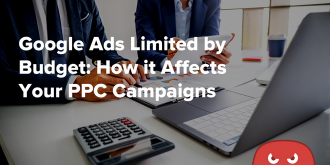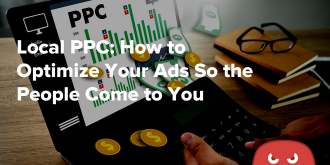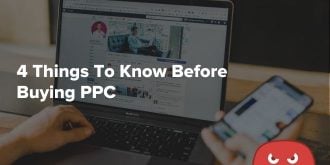Quick Links
When software-as-a-service businesses want to grow, it’s rarely a good idea to take out a Super Bowl Ad or billboard. Even if you reach millions, you might only reach a handful in your target market.
It’s a lot more cost-effective to target only your ideal customers. That’s the goal of any SaaS pay-per-click (PPC) campaign.
With platforms like Google Ads, you can market to people actively searching for terms directly related to your business.
When done right, you can create laser-focused campaigns — less traveling salesman going door to door, more executive sales manager meeting with an already interested potential customer.
In this article, we’ll cover the basics of creating an effective SaaS PPC strategy, the differences between approaches for B2B and B2C consumers, how to forecast results and profitability, and more.
What is PPC? (and why it’s a great marketing tool for SaaS businesses)
PPC is short for pay-per-click advertising, a mode of internet advertising where you pay for the clicks your ad receives instead of a set amount for a number of days or views.
Most digital marketers use the term primarily for search engine marketing platforms, like Google Ads, reserving the term “social media ads” for PPC ads on social platforms.
What’s unique about ads on search engines is that you can advertise directly to people in the middle of taking an action that identifies them as your ideal customer.
For example, they could be searching for “best enterprise project management app.”
That’s what makes PPC so powerful. It’s a unique targeting ability that you just can’t get elsewhere with demographics and other info.
The only other way you could know that someone is looking for your product at any given time is if they actively contact your company.
So PPC allows you to create highly targeted campaigns that reach potential customers at scale. You can even adjust your ad messaging based on exactly what they’re looking for.
If they want an enterprise project management solution, you can highlight relevant features in the ad. If they want an SMB solution, you can highlight your freemium option.
Another aspect of PPC that makes it a perfect match for SaaS is how easy it is to track results. There’s nothing theoretical about the return on investment in PPC ads. You can see exactly what results they drive in real-time.
Some info you can see includes:
- Which ads get more clicks and resonate more with your audience
- Which keywords drive clicks and conversions
- Customer acquisition cost (CAC)
- Where on the results page your ads tend to show up based on your bids
These and other PPC metrics are available inside the platform as long as you set up conversion tracking.
The main challenge with SaaS PPC: driving meaningful conversions
PPC is a perfect medium for SaaS, as search terms clearly identify someone as being in your ideal target market.
However, converting SaaS buyers in a single interaction is notoriously difficult, especially online. SaaS companies had one of the lowest average conversion rates in 2020, clocking in at 2.4%.
That’s almost five times lower than media and over twice as low as finance. Plus, this data is for leads and freemium users, not actual paying customers.
For SaaS, PPC isn’t just a money spout you can turn on to automatically make money. With a bad angle and no strategy, you’re likely to lose money on your ads.
And it’s not enough to just optimize your ad copy or keywords. You need to take the time to position your company correctly, create a sales funnel that nurtures leads over time, and set up an effective onboarding process to engage freemium and paying users.
If you fall short at any stage, your campaigns are unlikely to deliver positive long-term results.
But enough theory, let’s cover how to create PPC campaigns that land you paying customers.
How to create PPC campaigns for SaaS (that actually land you paying customers)
This section outlines the nitty-gritty details of creating PPC campaigns for SaaS. We help you develop your overall strategy based on your target audience, select effective keywords, optimize campaign structure, and more.
Before we dive in: key differences in PPC goals for B2B and B2C-focused SaaS
The ideal way to structure your marketing is different for B2B and B2C-focused SaaS.
In 2020, B2B SaaS marketers listed events as the number one marketing channel for this very reason.
Why? Most companies struggle to jump straight to sales from the first interaction, while — depending on the keyword — you might want to take a completely different approach.
By creating a SaaS PPC strategy that includes other channels — like email marketing and retargeting on social media — you can establish relationships with potential customers and build trust over time.
It also gives you many more opportunities to sell to a prospective customer than just that first interaction from the initial PPC click.
One effective strategy is to use virtual events or webinars covering your prospect’s pain points to generate leads.
The webinar is a great sales opportunity, and you can continue nurturing the relationship through email over time.
If you’re focused on regular consumers or freelancers, a push straight to a freemium product might be more effective.
Calculate the average value of leads/freemium users to forecast ROI
Before investing in ads, you need to understand how much each new lead or freemium user is worth.
Early in the process, that’s the only way to forecast potential returns from your ads. So look at your existing customer data and pinpoint these metrics:
- Customer lifetime value (CLTV)
- Freemium to paid conversion rate
- Average value of a freemium user (CLTV / freemium to paid conversion rate)
- Average lead conversion rate & deal value
Once you have an idea of how much each lead tends to be worth, you’ll know what your ideal acquisition cost should be.
Forget about vanity metrics like cost-per-click (CPC) and click-through rate (CTR). The cost to acquire paying customers is the only thing that matters.
Start with long-tail middle-of-funnel (or lower) keywords
If your SaaS is SPAC-funded with an unlimited ad budget, you might want to consider general top-of-funnel keywords. However, these are unlikely to drive results in the short term.
Instead, focus on middle or bottom-of-the-funnel keywords.
These keywords indicate a customer’s need for your product or service and express interest in paying for a solution like yours.
A top-of-funnel keyword is just an indicator that they have a problem you can solve. They might not have the budget or time to invest in a new software solution at the moment.
Not sure how to implement this for your business? HOTH PPC can help you identify high-value long-tail keywords that drive sales.
Tailor landing pages to the needs of each audience
Not every customer segment has the same problems and priorities. And with PPC, there’s no reason to use a single generic landing page for every prospect.
Often the search intent of a keyword implies different needs than what your general product landing page highlights.
For example, if they’re searching for a “CRM that integrates with Stripe,” you should create a focused landing page that highlights that.
The same goes for any specific segment of customers like “small business CRM,” “enterprise CRM,” etc.
For example, Slack has a completely different landing page targeting enterprise keywords.
Notice how it focuses on scale and security instead of the casual “Slack is your digital HQ” on its main LP.
Follow basic PPC principles, like using a STAG campaign structure
To deliver relevant ads and landing pages, you need to set up your campaign’s structure the right way.
One strategy that professional PPC marketers (including us) vouch for is called STAG — single theme ad groups.
It’s when you divide your campaign into ad groups that concentrate on related keywords that focus on the same theme. For example, “SMB accounting software” and “small business account app” would be in the same ad group.
You can then create ads and landing pages that resonate with users who search for these types of keywords.
“Message match” is a core principle of search engine marketing and can be highly effective. The good news is that it’s also simple to implement if you start out with it in mind.
Integrate Google Ads with your CRM to see which keywords drive sales
If you truly want to optimize your ad spend on ad platforms, you need to understand where the paying customers come from.
Leads and free users are a great mid-way point for forecasting revenue, but these metrics don’t show the whole picture.
A keyword like “free accounting app” could bring in hundreds of free users — versus only ten from “enterprise accounting software” — and still bring in less revenue.
To help you make data-driven decisions about which keywords to prioritize, you should integrate your CRM with Google Ads.
That way, you can see stats like average deal value broken down by keywords, campaigns, and even ads.
If you’ve expanded to Bing Ads, you should also integrate that platform.
Use retargeting strategically to ease concerns and drive sales
Retargeting ads are display ads targeting users that have already interacted with your site. If you’re not a seasoned marketer, your first impression might be “those annoying ads that make me feel stalked?”
But remarketing ads, when done right, can be an incredibly effective tool for overcoming objections and driving conversions and sales.
By using remarketing ads, you can:
- Create a remarketing audience based on specific pages — like a pricing page or an industry-specific product landing page. (Don’t spam everyone who’s visited your blog ever).
- Exclude paying customers who are using your product.
- Promote case studies or videos of your product in action that allay common objections your sales teams hear from prospective customers.
Combine with other channels — like email marketing or even live events
Even if you’re not a B2B SaaS company, you should still want to enhance your PPC efforts with an effective marketing mix.
Not integrating with other channels is one of the most common PPC mistakes we see companies make.
For SaaS, an ideal marketing mix might look something like this:
- Traditional B2B marketing — events, field sales: To meet and close prospects in person.
- PPC: To reach potential customers close to making a product decision.
- Digital events: To nurture potential customers, showcase the power of your product, and overcome objections.
- Email marketing: To nurture potential customers and onboard free users.
- Content marketing and SEO: To increase brand awareness, nurture potential customers, and showcase your products.
- Social media marketing: To increase brand awareness and nurture potential customers.
With search engine optimization (SEO), you could theoretically get organic traffic for your PPC search terms, but this is a long and challenging process — especially since SaaS keywords tend to be very competitive. For more information on SEO services, check out HOTH X.
By combining both, you can create informative content that targets fewer commercial keywords, builds trust and authority, and gradually lays the foundation for ranking on competitive keywords in the future. All this while not missing out on valuable bottom-of-funnel traffic thanks to your PPC campaigns.
Use PPC to quickly test new markets (countries, industry-specific software, etc.)
If you’re just starting to expand beyond businesses in your local area, PPC can be a great channel for testing new markets and market segments.
For example, if you’re exploring the possibility of becoming a vertical SaaS — creating software that focuses on the needs of a specific industry — you can test the demand with paid search ads and landing pages.
For example, “CRM for auto dealers” is a vertical-specific keyword within the wider CRM category.
You can also try marketing in neighboring states or countries to identify areas with potential.
Learn from the data and improve messaging and targeting over time
Before you spend a single cent on PPC ads, you should have proper analytics and conversion tracking set up.
Otherwise, all your optimization efforts will be based on nothing but guesswork.
Set up Google Analytics with conversion goals from day one. By tracking conversions through Google Analytics instead of Google Ads, you can see which other channels played a role in driving conversions.
You can also see detailed performance data on your Google Ads campaigns, including the acquisition cost for each keyword, ad, and landing page.
Use these data points to focus on the keywords that drive the best results, and use bounce rate and other metrics to optimize your landing pages.
Ready to start using PPC in your SaaS marketing strategy?
If you’re looking to generate more sales, not just traffic and brand awareness, PPC is the most important digital channel.
But unless you know what you’re doing, it can end up costing you money instead of becoming a sales driver.
You need to have the right strategy and mix of channels, target the right keywords, create effective landing pages, and much more.
If this all seems overwhelming, and you’d like to spend your time improving your product, not learning the ins and outs of PPC marketing, schedule a call with our PPC experts today.

















